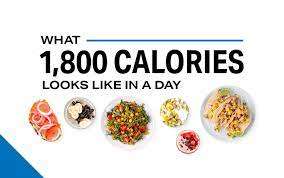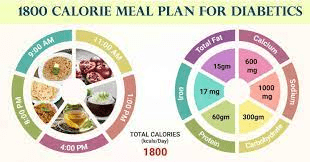
Welcome to our comprehensive 1800 ADA Diabetic Diet Guide! Living with diabetes can be challenging, but with the right dietary choices, you can lead a healthy, active life.
The American Diabetes Association (ADA) has developed guidelines to help diabetics manage their blood sugar levels effectively. In this guide, we’ll explore the ins and outs of the 1800 ADA Diabetic Diet, complete with meal plans, expert tips, and answers to your burning questions. Let’s get started!
Understanding the 1800 ADA Diabetic Diet

What is the 1800 ADA Diabetic Diet?
The 1800 ADA Diabetic Diet is a meal plan that focuses on providing around 1800 calories per day while emphasizing healthy food choices. It’s designed to help people with diabetes manage their blood sugar levels by following the guidelines set by the American Diabetes Association (ADA).
The diet encourages a balance of carbohydrates, proteins, and fats while keeping an eye on portion sizes. This approach helps diabetics maintain optimal blood sugar levels and overall health.
The Importance of Portion Control
Portion control is crucial in managing diabetes, as it ensures you’re consuming the right amount of nutrients without overeating. Overeating can lead to weight gain and increased blood sugar levels, both of which can exacerbate diabetes complications.

Measuring Your Food
To measure your food accurately, consider investing in a food scale and measuring cups. Weighing your food and using measuring cups will help you stay on track with your 1800 ADA Diabetic Diet.
Visual Aids for Portion Control
If you’re new to portion control, visual aids can be helpful. For example, a deck of cards represents a proper serving size of meat, while a tennis ball is equivalent to a serving of fruit.
Building Your 1800 ADA Diabetic Diet Meal Plan
Carbohydrates:
The Key to a Balanced Diabetic Diet Carbohydrates play a significant role in a diabetic diet, as they provide energy and directly affect blood sugar levels.
There are two types of carbs: simple and complex. Simple carbs, such as sugar and white bread, can cause rapid spikes in blood sugar levels, while complex carbs, like whole grains and legumes, release glucose slowly, promoting more stable blood sugar levels.
The Glycemic Index
The glycemic index (GI) is a helpful tool in understanding how different carbs affect blood sugar levels. Foods with a low GI value (55 or less) are preferable, as they cause a slower, steadier rise in blood sugar.
Carb Counting and Diabetes
Carb counting involves tracking the number of carbohydrates consumed in each meal and adjusting insulin doses accordingly. This method helps diabetics maintain better control over their blood sugar levels.
How to Include Healthy Carbs in Your Diet
To include healthy carbs in your diet, opt for whole grains, such as brown rice, quinoa, and whole wheat bread. You can also get your carb fix from fruits, vegetables, and legumes. Remember to monitor your portion sizes to stay within your daily carb allowance.
Protein:
The Building Blocks of Your Diet Protein is vital in a diabetic diet, as it helps build and repair tissues and supports overall health.
Healthy protein sources include lean meats, poultry, fish, eggs, dairy products, legumes, and nuts. Aim to include a protein source in every meal, focusing on lean options to minimize saturated fat intake.
Fats:
The Good, the Bad, and the Ugly Fats play an essential role in a diabetic diet, providing energy and supporting cell growth. However, not all fats are created equal.
Good fats, such as monounsaturated and polyunsaturated fats, can help improve blood cholesterol levels and reduce the risk of heart disease. Bad fats, like saturated and trans fats, can negatively impact your heart health and overall well-being.
Healthy fat sources include avocados, olive oil, nuts, seeds, and fatty fish like salmon and mackerel. Be mindful of your fat intake and opt for good fats whenever possible.
Fiber:
The Unsung Hero of Diabetic Diets: Fiber is often overlooked but plays a crucial role in a diabetic diet. It helps regulate digestion, lower cholesterol levels, and maintain stable blood sugar levels.
High-fiber foods include fruits, vegetables, whole grains, and legumes. Aim to incorporate fiber-rich foods into every meal to reap the benefits.
Vitamins and Minerals:
Supporting Your Diabetic Diet Vitamins and minerals are essential nutrients that support various bodily functions. Key vitamins and minerals for diabetics include vitamin C, vitamin D, magnesium, potassium, and zinc.
To ensure you’re meeting your nutrient needs, eat a diverse range of fruits, vegetables, whole grains, lean proteins, and healthy fats.
Sample 1800 ADA Diabetic Diet Menu
Breakfast Options
- Whole grain toast with avocado and a side of mixed berries
- Greek yogurt with nuts, seeds, and a drizzle of honey
- Veggie omelet with spinach, tomatoes, onions, and low-fat cheese
Lunch Options
- Grilled chicken salad with mixed greens, cherry tomatoes, cucumber, and vinaigrette dressing
- Turkey and avocado wrap on whole wheat tortilla with a side of baby carrots
- Quinoa and black bean salad with corn, bell peppers, and cilantro-lime dressing
Dinner Options
- Baked salmon with roasted asparagus and a side of brown rice
- Lentil and vegetable curry served over whole grain basmati rice
- Turkey meatballs with whole wheat spaghetti and marinara sauce
Snack Options
- Apple slices with almond butter
- Low-fat cottage cheese with pineapple chunks
- Raw veggies with hummus
Expert Tips for Success on the 1800 ADA Diabetic Diet
Planning Your Meals
Meal planning and prepping can help you stay consistent with your 1800 ADA Diabetic Diet. Set aside time each week to plan out your meals, create a shopping list, and prep ingredients to save time during the week.
Hydration:
Don’t Forget About Water Staying hydrated is essential for diabetics. Proper hydration helps regulate blood sugar levels, aids in digestion, and supports overall health. Aim to drink at least eight 8-ounce glasses of water per day.
Listening to Your Body
Pay attention to your body’s hunger and fullness cues. Eating mindfully and responding to these signals can help you maintain a healthy weight and better control your diabetes.
Regular Exercise and the Diabetic Diet
Incorporating regular exercise into your routine can help manage diabetes and improve overall health. Aim for at least 150 minutes of moderate-intensity aerobic activity each week, along with strength training exercises.
Frequently Asked Questions (FAQ)
Can I have dessert on the 1800 ADA Diabetic Diet?
Yes, you can enjoy dessert while following the 1800 ADA Diabetic Diet, but moderation is key. Opt for desserts that are lower in sugar and carbs, such as fresh fruit with a dollop of Greek yogurt or a small square of dark chocolate. Keep portion sizes in check and enjoy your treat without guilt.
How can I dine out while following the 1800 ADA Diabetic Diet?
Dining out while following the 1800 ADA Diabetic Diet is possible with a little planning and mindfulness. Research the restaurant’s menu beforehand and look for dishes that align with your meal plan. Don’t be afraid to ask for modifications, such as swapping out fries for a side salad or requesting sauces on the side. Keep an eye on portion sizes and consider taking half of your meal home for later if servings are too large.
Conclusion
Following the 1800 ADA Diabetic Diet may seem challenging at first, but with proper planning, portion control, and a focus on balanced nutrition, you’ll be well on your way to a healthier lifestyle.
Use this guide as a starting point to create your personalized meal plan and remember that consistency is key to success. Here’s to your health and happiness on the 1800 ADA Diabetic Diet journey!



